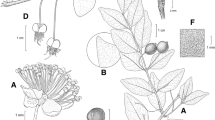Summary
A third species ofHarpanthus Nees —H. drummondii (Tayl.) n. c. — was recognized from eastern N.-America. Its main differences are special ± erected shoots with apical gemmae and a much less developed perigynium. Detailed description of the genusHarpanthus with new data on gemmae and antheridia of this genus. Key to and drawings of theHarpanthus species. Notes onGeocalyx and the relationsships of Geocalycaceae includingHarpanthus.
Similar content being viewed by others
Literaturverzeichnis
Abramov, I. I. et al. (1964): Ad floram Caucasicam Hepaticarum (Bakuriani). Notul. System. Sect. Crypt.17, 275–285.
Allorge, P. (1935): Notes sur la flore bryologique de la Péninsule ibérique. IX. Rev. Bryol. Lichén.7, 249–301.
Arnell, H. W. (1928): Levermossor. InHolmberg: Skandinaviens Flora2a, 1–224, Stockholm.
Arnell, S. (1957): Illustrated Moss Flora of Fennoscandia. I. Hepaticae 1–308, Lund.
Buch, H. (1911): Über die Brutorgane der Lebermoose 1–70, Helsingfors.
- (1936): Suomen Maksasammalet 1–116, Helsinki.
Buch, H., etR. Tuomikoski (1955): Contribution to the Hepatic flora of New Foundland. Arch. Soc. Zool. Bot. Fenn. ‚Vanamo‘9 (Suppl.): 1–29.
Degenkolbe, W. (1937): Brutorgane bei beblätterten Lebermoosen. Ann. Bryol.10, 43–96.
Frye, T. C., etL. Clark (1945): Hepaticae of North America. III. Univ. Washington Publ. Biol.6, 337–564.
Gottsche, C. M. et al. (1844–1847): Synopsis Hepaticarum 1–834, Hamburg.
Grolle, R. (1960 a): ÜberSaccogyna Dum. undSaccogynidium, eine neue Lebermoosgattung. Jour. Hattori Bot. Lab.23, 41–67.
— (1960 b): Nachtrag zur ‚Revision derClasmatocolea-Arten‘. Rev. Bryol. Lichén.29, 68–91.
Hattori, S. (1952): Hepaticae of Shikoku and Kyushu, Southern Japan (1). Jour. Hattori Bot. Lab.7, 38–61.
— (1953): Notes on little known Japanese species of Hepaticae (3). Jour. Jap. Bot.28, 231–235. (Nicht gesehen.)
Inoue, H. (1962): Hepaticae and Anthocerotae of the Chichibu-Okutama Mountains, Central Japan. Jour. Hattori Bot. Lab.25, 186–216.
Limpricht, K. G. (1875): Lebermoose. InCohn: Kryptogamen-Flora von Schlesien1, 225–352, 429–443, Breslau.
Loitlesberger, K. (1894): Vorarlbergische Lebermoose. Verhandl. K. K. Zool. Bot. Ges.44, 239.
Macvicar, S. M. (1926): The Student's Handbook of British Hepatics, 2. Aufl., 1–464, London.
Meylan, Ch. (1924): Lés Hépatiques de la Suisse 1–318, Zürich.
Mitten, W. (1865): The ‚Bryologia‘ of the Survey of the 49th Parallel of Latitude. Jour. Proc. Linn. Soc. Bot.8, 12–55.
Müller, K. (1911): Die Lebermoose. InRabenhorst: Kryptogamen-Flora von Deutschland usw., 2. Aufl.,6 (1), 769–871, Leipzig.
- (1956): Die Lebermoose Europas. InRabenhorst: Kryptogamen-Flora von Deutschland usw., 3. Aufl.,6, 751–1220, Leipzig.
Nees Von Esenbeck, C. G. (1833–1838): Naturgeschichte der Europäischen Lebermoose, 1–4, Berlin.
Pavletic, Z. (1955): Prodromus Flore Briofita Jugoslawije, 1–578, Zagreb.
Watson, W. (1922): Spitzbergen Liverworts. Jour. Bot. London60, 327 bis 330.
Author information
Authors and Affiliations
Rights and permissions
About this article
Cite this article
Grolle, R. Harpanthus drummondii — ein Lebermoosendemit des östlichen Nordamerika. Osterr bot Z 112, 268–284 (1965). https://doi.org/10.1007/BF01372951
Received:
Issue Date:
DOI: https://doi.org/10.1007/BF01372951




